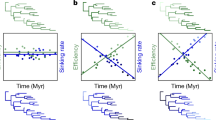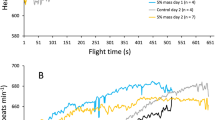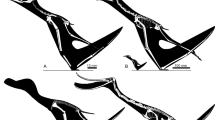Abstract
Since the late 1800s, the debate on the origin of flight in birds has centred around two antagonistic theories: the arboreal (take-off from trees) and cursorial (take-off from running) models1,2,3,4,5,6. Despite broad acceptance of the idea that birds evolved from bipedal and predominantly terrestrial maniraptoriform dinosaurs1,7, the cursorial model of flight origins has been less successful than the arboreal model. Three issues have contributed to this lack of success: the gap between the estimated maximum running speed of Archaeopteryx (2 metres per second) and its estimated minimum flying speed (6 metres per second)8; the high energy demands of evolving flight against gravity2,3; and the problem of explaining the origin of the ‘flight’ stroke in an earthbound organism3,4. Here we analyse the take-off run of Archaeopteryx through lift-off from an aerodynamic perspective, and emphasize the importance of combining functional and aerodynamic considerations with those of phylogeny1,9,10. Our calculations provide a solution to the ‘velocity gap’ problem and shed light on how a running Archaeopteryx (or its cursorial maniraptoriform ancestors) could have achieved the velocity necessary to become airborne by flapping feathered wings.
This is a preview of subscription content, access via your institution
Access options
Subscribe to this journal
Receive 51 print issues and online access
$199.00 per year
only $3.90 per issue
Buy this article
- Purchase on Springer Link
- Instant access to full article PDF
Prices may be subject to local taxes which are calculated during checkout



Similar content being viewed by others
References
Padian, K. & Chiappe, L. M. The early evolution of birds. Biol. Rev. 73, 1–42 (1998).
Norberg, U. M. Vertebrate Flight(Springer, Berlin, (1990).
Feduccia, A. The Origin and Evolution of Birds(Yale Univ. Press, New Haven, (1996).
Chatterjee, S. The Rise of Birds(John Hopkins Univ. Press, Baltimore, (1997).
Hecht, M. K. et al . The Beginnings of Birds(Freunde Jura-Museum, Eichstätt, (1985).
Padian, K. The Origin of Birds and the Evolution of Flight(Cal. Acad. Sci., San Francisco, (1986).
Gauthier, J. Saurischian monophyly and the origin of birds. Mem. Cal. Acad. Sci. 8, 1–55 (1986).
Rayner, J. M. V. in The Beginnings of Birds(eds Hecht, M. K. et al. ) 289–292 (Freunde Jura-Museum, Eichstätt, (1985).
Gauthier, J. & Padian, K. in The Beginnings of Birds(eds Hecht, M. K. et al. ) 185–197 (Freunde Jura-Museum, Eichstätt, (1985).
Padian, K. in Paleobiology(eds Briggs, D. E. G. & Crowther, P. R.) 75–79 (Blackwell, Oxford, (1990).
Rayner, J. M. V. in Biomechanics in Evolution(eds Rayner, J. M. V. & Wootton, R. J.) 183–212 (Cambridge Univ. Press, Cambridge, (1991).
Ostrom, J. H. Bird flight: how did it begin? Am. Sci. 67, 46–58 (1979).
Peters, D. S. & Gorgner, E. Acomparative study on the claws of Archaeopteryx . L.A. Co. Mus., Sci. Ser. 36, 29–37 (1992).
Chiappe, L. M. Climbing Aechaopteryx ? A Response to Yalden. Archaeopteryx 15, 109–112 (1997).
Poore, S. O., Ashcroft, A., Sánchez-Haiman, A. & Goslow, G. E. J The contractile properties of the M. supracoracoideus in the pigeon and starling: a case for long-axis rotation of the humerus. J. Exp. Biol. 200, 2987–3002 (1997).
Rayner, J. M. V. in The Beginnings of Birds(eds Hecht, M. K. et al. ) 279–288 (Freunde Jura-Museum, Eichstätt, (1985).
Jenkins, F. A. The evolution of the avian shoulder joint. Am. J. Sci. 293, 253–267 (1993).
Ostrom, J. H. How did flight might have come about. Dinofest Inter. Proc. 301–310 (1997).
Speakman, J. R. Flight capabilities in Archaeopteryx . Evolution 47, 336–340 (1993).
Norberg, R. A. & Norberg, U. M. Take-off, landing, and flight speed during fishing flights of Gavia stellata (Pont.). Ornis Scand. 2, 55–67 (1971).
Ruben, J. Reptilian physiology and the flight capacity of Archaeopteryx . Evolution 45, 1–17 (1991).
Caple, G. et al . The physics of leaping animals and the evolution of preflight. Am. Nat. 121, 455–476 (1983).
Novas, F. E. & Puerta, P. F. New evidence concerning avian origins from the Late Cretaceous of Patagonia. Nature 387, 390–392 (1997).
Ji, Q., Currie, P. J., Norell, M. A. & Ji, S. Two feathered dinosaurs from northeastern China. Nature 393, 753–761 (1998).
Nopcsa, F. Ideas on the origin of flight. Proc. Zool. Soc. Lond. 1907, 223–236 (1907).
Nopcsa, F. On the origin of flight in birds. Proc. Zool. Soc. Lond. 1923, 463–477 (1923).
Yalden, D. W. The flying ability of Archaeopteryx . Ibis 113, 349–356 (1971).
Burgers, P. A Computational Analysis of the Aerodynamic Interference Between Two Birds Flying in Formation and in Ground Effect Simultaneously. Thesis, The Union Institute, Cincinnati, Ohio(1996).
Acknowledgements
We are grateful to H. Bertsch, A. Brush, A. Gaunt, P. MacCready, K. Padian, J.Ostrom, G. Spedding, and M. Warner for discussions, to P. Rollings for the illustrations and to S. Orell for editorial assistance. J. M. V. Rayner provided insightful comments on the earlier versions of the manuscript. Support provided by the Frank M. Chapman Memorial Fund of the American Museum of Natural History.
Author information
Authors and Affiliations
Rights and permissions
About this article
Cite this article
Burgers, P., Chiappe, L. The wing of Archaeopteryx as a primary thrust generator. Nature 399, 60–62 (1999). https://doi.org/10.1038/19967
Received:
Accepted:
Issue Date:
DOI: https://doi.org/10.1038/19967
This article is cited by
-
The relationship between sternum variation and mode of locomotion in birds
BMC Biology (2021)
-
Unusual pectoral apparatus in a predatory dinosaur resolves avian wishbone homology
Scientific Reports (2021)
-
Wing bone geometry reveals active flight in Archaeopteryx
Nature Communications (2018)
-
Jurassic archosaur is a non-dinosaurian bird
Journal of Ornithology (2014)
-
The evolutionary continuum of limb function from early theropods to birds
Naturwissenschaften (2009)
Comments
By submitting a comment you agree to abide by our Terms and Community Guidelines. If you find something abusive or that does not comply with our terms or guidelines please flag it as inappropriate.



